check engine CITROEN RELAY 2014 Handbook (in English)
[x] Cancel search | Manufacturer: CITROEN, Model Year: 2014, Model line: RELAY, Model: CITROEN RELAY 2014Pages: 186, PDF Size: 4.72 MB
Page 5 of 186
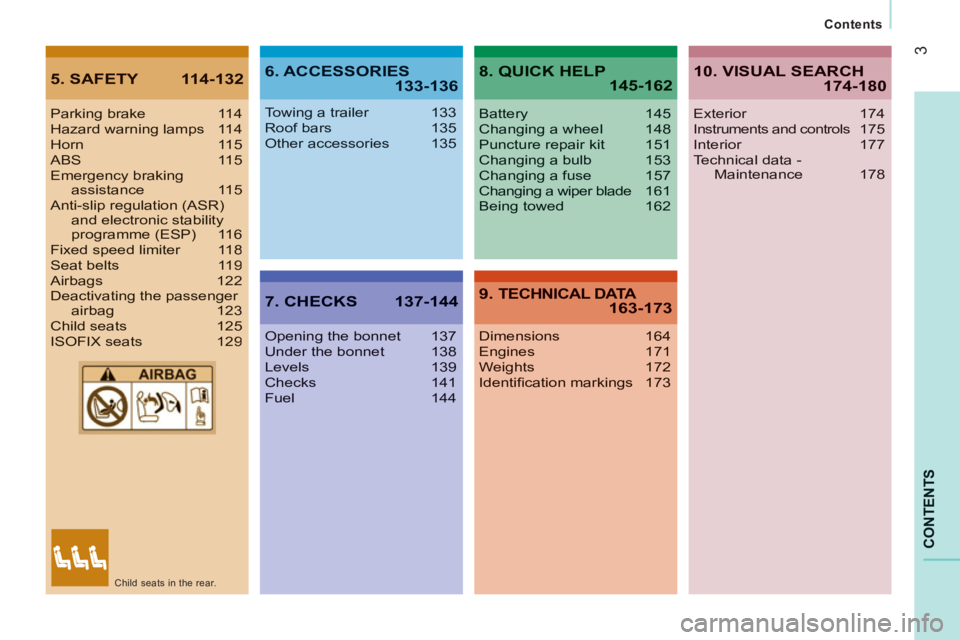
3
CONTENT
S
Contents
5. SAFETY 114-1326. ACCESSORIES133-136
7. CHECKS 137-144
8. QUICK HELP145-162
9. TECHNICAL DATA 163-173
Parking brake 114Hazard warning lamps 114Horn 115ABS 115Emergency brakingassistance 115Anti-slip regulation (ASR) and electronic stabilityprogramme (ESP) 116Fixed speed limiter 118Seat belts 119Airbags 122Deactivating the passenger airbag 123Child seats 125ISOFIX seats 129
Towing a trailer 133Roof bars 135Other accessories 135
Opening the bonnet 137Under the bonnet 138Levels 139Checks 141Fuel 144
Battery 145Changing a wheel 148Puncture repair kit 151Changing a bulb 153Changing a fuse 157Changing a wiper blade 161Being towed 162
Dimensions 164Engines 171Weights 172Identifi cation markings 173
10. VISUAL SEARCH 174-180
Exterior 174Instruments and controls175Interior 177Technical data - Maintenance 178
Child seats in the rear.
Page 22 of 186
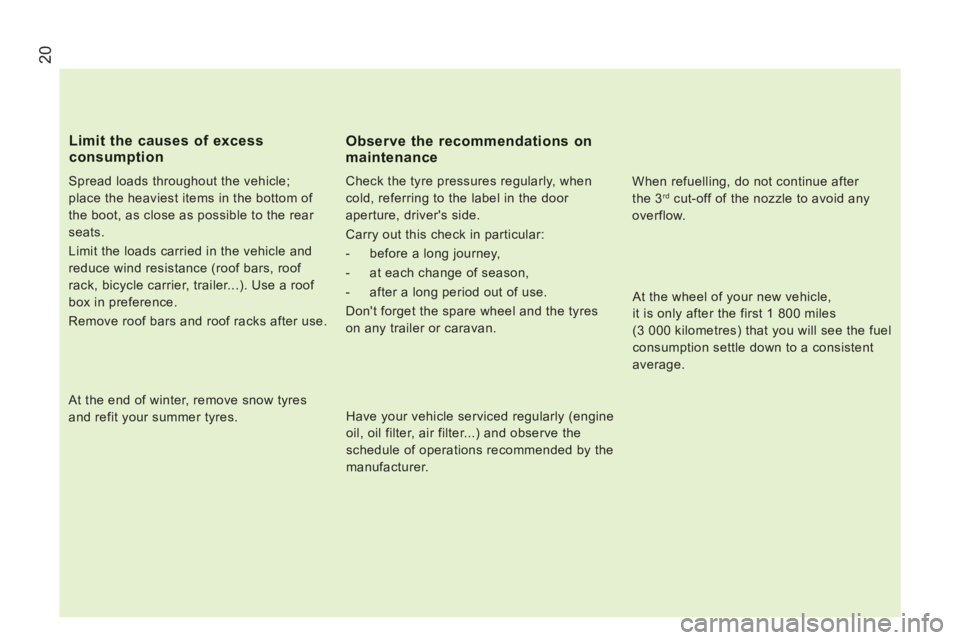
20
Spread loads throughout the vehicle;
place the heaviest items in the bottom of
the boot, as close as possible to the rear
seats.
Limit the loads carried in the vehicle and
reduce wind resistance (roof bars, roof
rack, bicycle carrier, trailer...). Use a roof
box in preference.
Remove roof bars and roof racks after use.
Limit the causes of excess
consumption
At the end of winter, remove snow tyres
and refit your summer tyres.
Observe the recommendations on maintenance
Check the tyre pressures regularly, when
cold, referring to the label in the door
aperture, driver's side.
Carry out this check in particular:
- before a long journey,
- at each change of season,
- after a long period out of use.
Don't forget the spare wheel and the tyres
on any trailer or caravan.
Have your vehicle serviced regularly (engine
oil, oil filter, air filter...) and observe the
schedule of operations recommended by the
manufacturer.
When refuelling, do not continue after
the 3 rd cut-off of the nozzle to avoid any
overflow.
At the wheel of your new vehicle,
it is only after the first 1 800 miles
(3 000 kilometres) that you will see the fuel
consumption settle down to a consistent
average.
Page 27 of 186
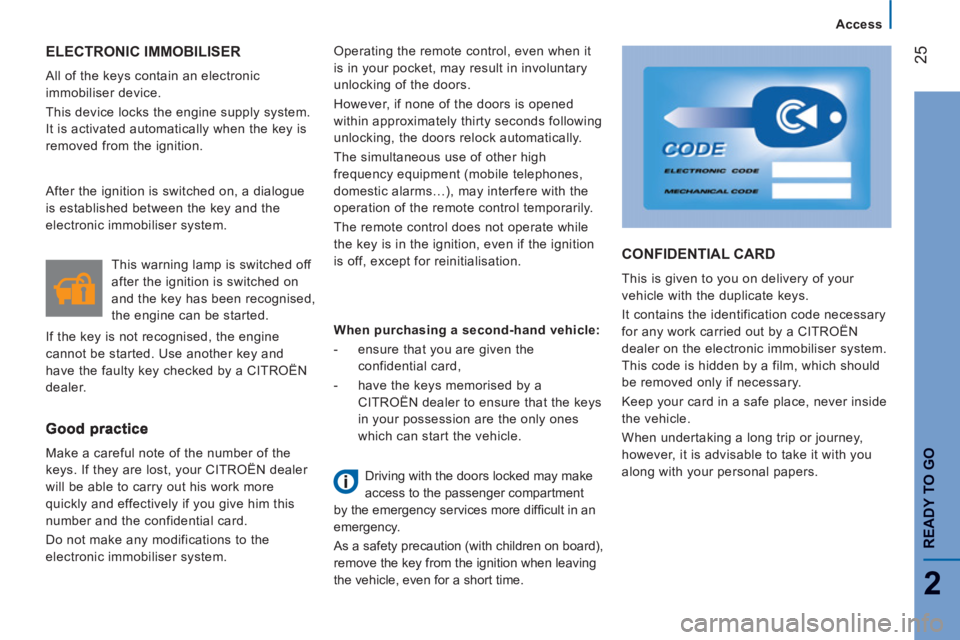
25
2
Access
READY TO G
O
ELECTRONIC IMMOBILISER
All of the keys contain an electronic
immobiliser device.
This device locks the engine supply system.
It is activated automatically when the key is
removed from the ignition. Operating the remote control, even when it
is in your pocket, may result in involuntary
unlocking of the doors.
However, if none of the doors is opened
within approximately thirty seconds following
unlocking, the doors relock automatically.
The simultaneous use of other high
frequency equipment (mobile telephones,
domestic alarms…), may interfere with the
operation of the remote control temporarily.
The remote control does not operate while
the key is in the ignition, even if the ignition
is off, except for reinitialisation.
Make a careful note of the number of the
keys. If they are lost, your CITROËN dealer
will be able to carry out his work more
quickly and effectively if you give him this
number and the confidential card.
Do not make any modifications to the
electronic immobiliser system. This warning lamp is switched off
after the ignition is switched on
and the key has been recognised,
the engine can be started.
If the key is not recognised, the engine
cannot be started. Use another key and
have the faulty key checked by a CITROËN
dealer.
Driving with the doors locked may make
access to the passenger compartment
by the emergency services more diffi cult in an
emergency.
As a safety precaution (with children on board),
remove the key from the ignition when leaving
the vehicle, even for a short time. After the ignition is switched on, a dialogue
is established between the key and the
electronic immobiliser system.
When purchasing a second-hand vehicle:
- ensure that you are given the
confidential card,
- have the keys memorised by a
CITROËN dealer to ensure that the keys
in your possession are the only ones
which can start the vehicle.
CONFIDENTIAL CARD
This is given to you on delivery of your
vehicle with the duplicate keys.
It contains the identification code necessary
for any work carried out by a CITROËN
dealer on the electronic immobiliser system.
This code is hidden by a film, which should
be removed only if necessary.
Keep your card in a safe place, never inside
the vehicle.
When undertaking a long trip or journey,
however, it is advisable to take it with you
along with your personal papers.
Page 31 of 186

29
2
Access
READY TO G
O
LOCKING/UNLOCKING FROM INSIDE
Door open warnin
g lamp
If this warning lamp comes on,
check that the cab doors, the rear
or side doors and the bonnet are
closed correctly.
Good practice
If you decide to drive with the doors locked,
be aware that this could make access to the
vehicle by the emergency services more
difficult in an emergency.
Cab and load space
Pressing permits electric central
locking, when the doors are
closed.
Pressing permits electric central
unlocking.
The doors can still be opened from the
inside.
If one of the doors is open or is not
closed correctly, the central locking
does not work. The indicator lamp on the control:
- comes on when the doors
are locked and the ignition is
switched on,
- then flashes when the doors
are locked when stationary with
the engine off.
The control is not active when the vehicle
has been locked using the remote control or
the key from the outside.
Load space
Press to lock or unlock the side
door and rear doors from the cab.
The warning lamp remains on on
locking.
Protection against attack
When the vehicle is started, the system
locks the cab and load space doors
automatically when you reach approximately
12 mph (20 km/h).
If none of the doors is opened during the
journey, the locking remains active.
Activation/deactivation of the function
The function is activated/deactivated by
means of Mode, selecting "Autoclose".
Refer to the "Mode" section in
chapter 4.
Page 33 of 186
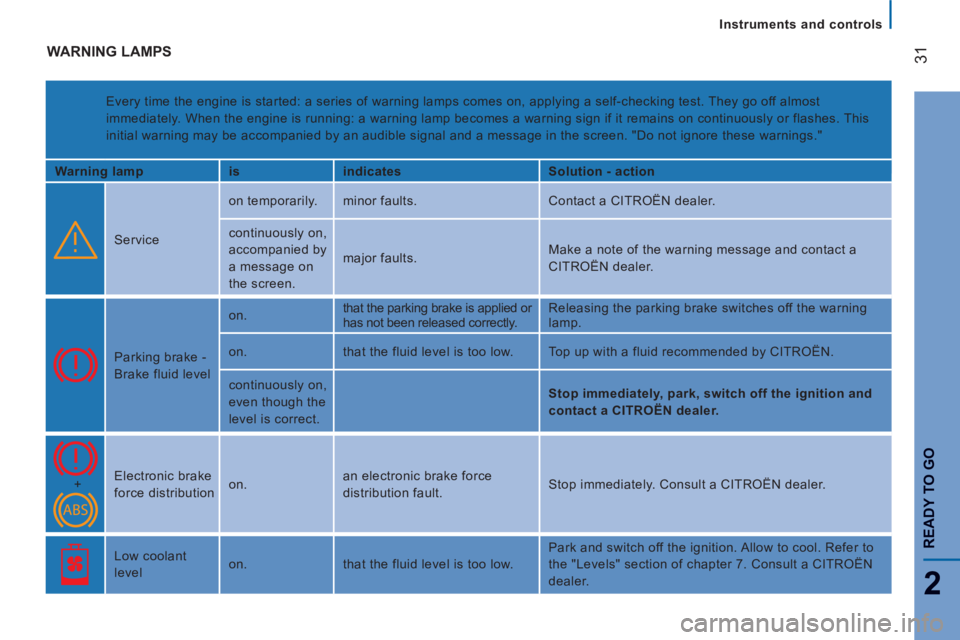
31
2
READY TO G
O
Instruments and controls
WARNING LAMPS
Every time the engine is started: a series of warning lamps comes on, applying a self-checking test. They go off almost
immediately. When the engine is running: a warning lamp becomes a warning sign if it remains on continuously or flashes. This
initial warning may be accompanied by an audible signal and a message in the screen. "Do not ignore these warnings."
Warning lamp
is
indicates
Solution - action
Service on temporarily. minor faults. Contact a CITROËN dealer.
continuously on,
accompanied by
a message on
the screen. major faults. Make a note of the warning message and contact a
CITROËN dealer.
Parking brake -
Brake fluid level on. that the parking brake is applied or
has not been released correctly. Releasing the parking brake switches off the warning
lamp.
on. that the fluid level is too low. Top up with a fluid recommended by CITROËN.
continuously on,
even though the
level is correct.
Stop immediately, park, switch off the ignition and
contact a CITROËN dealer.
+ Electronic brake
force distribution on. an electronic brake force
distribution fault. Stop immediately. Consult a CITROËN dealer.
Low coolant
level on. that the fluid level is too low. Park and switch off the ignition. Allow to cool. Refer to
the "Levels" section of chapter 7. Consult a CITROËN
dealer.
Page 34 of 186
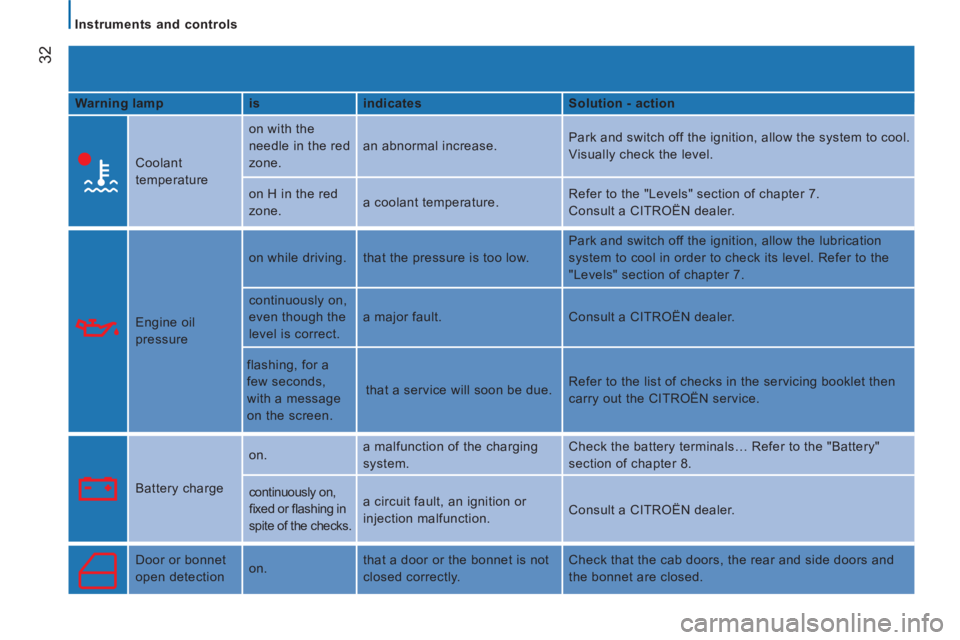
32
Instruments and controls
Warning lamp
is
indicates
Solution - action
Coolant
temperature on with the
needle in the red
zone. an abnormal increase. Park and switch off the ignition, allow the system to cool.
Visually check the level.
on H in the red
zone. a coolant temperature. Refer to the "Levels" section of chapter 7.
Consult a CITROËN dealer.
Engine oil
pressure on while driving. that the pressure is too low. Park and switch off the ignition, allow the lubrication
system to cool in order to check its level. Refer to the
"Levels" section of chapter 7.
continuously on,
even though the
level is correct. a major fault. Consult a CITROËN dealer.
flashing, for a
few seconds,
with a message
on the screen. that a service will soon be due. Refer to the list of checks in the servicing booklet then
carry out the CITROËN service.
Battery charge on. a malfunction of the charging
system. Check the battery terminals… Refer to the "Battery"
section of chapter 8.
continuously on,
fi xed or fl ashing in
spite of the checks. a circuit fault, an ignition or
injection malfunction. Consult a CITROËN dealer.
Door or bonnet
open detection on. that a door or the bonnet is not
closed correctly. Check that the cab doors, the rear and side doors and
the bonnet are closed.
Page 36 of 186

34
Instruments and controls
Warning lamp
is
indicates
Solution - action
ASR/ESP flashing. that it is in operation. The system optimises traction and allows improved
directional stability of the vehicle.
on,
accompanied
by an audible
signal and a
message in the
screen. its malfunction or failure of the
hill start assist.
Consult a CITROËN dealer.
Refer to the "Driving safety" section of chapter 5.
on. a fault with the Intelligent
Traction Control.
Anti-pollution on. the regeneration of the particle
emissions filter. It is recommended that you leave the engine running
until the warning lamp goes off so that regeneration can
be completed. Section 7, "Checks".
Emission control
system on. a fault with the system. Have the system checked by a CITROËN dealer without
delay.
Deactivation
of the front
passenger airbag on. the intentional deactivation of
this airbag when a rear facing
child seat is installed. Configure via the trip computer MODE menu. Refer to
the "Mode" section of chapter 4.
Electronic
immobiliser on. the ignition key inserted is not
recognised.
The vehicle cannot be started. Use another key and have the faulty key checked by
a CITROËN dealer. Refer to the "Access" section of
chapter 2.
Front brake
pads on. brake pad wear. Have the pads replaced by a CITROËN dealer.
Page 39 of 186
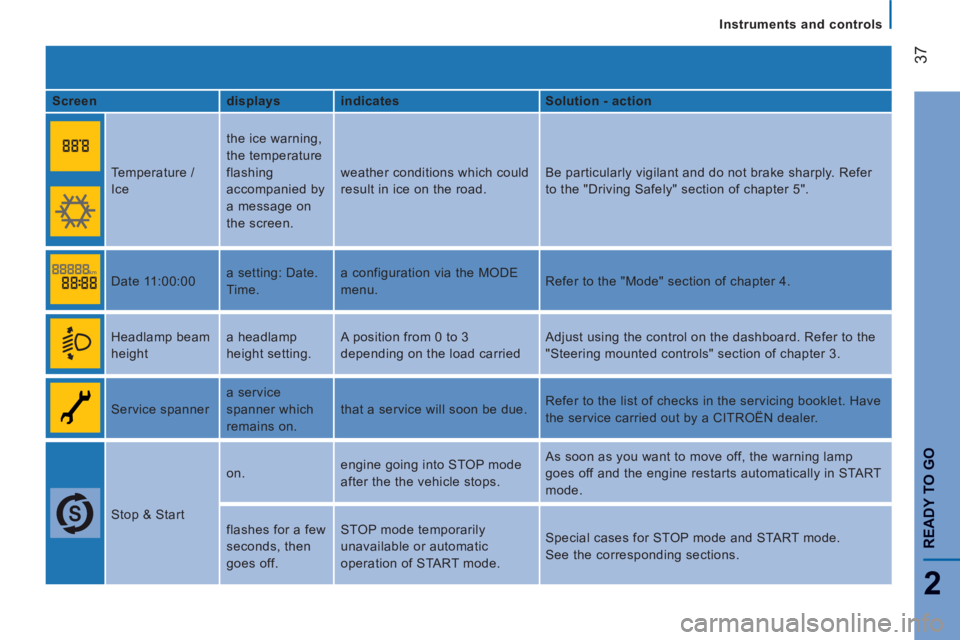
37
2
READY TO G
O
Instruments and controls
Screen
displays
indicates
Solution - action
Temperature /
Ice the ice warning,
the temperature
flashing
accompanied by
a message on
the screen. weather conditions which could
result in ice on the road. Be particularly vigilant and do not brake sharply. Refer
to the "Driving Safely" section of chapter 5".
Date 11:00:00 a setting: Date.
Time. a configuration via the MODE
menu. Refer to the "Mode" section of chapter 4.
Headlamp beam
height a headlamp
height setting. A position from 0 to 3
depending on the load carried Adjust using the control on the dashboard. Refer to the
"Steering mounted controls" section of chapter 3.
Service spanner a service
spanner which
remains on. that a service will soon be due. Refer to the list of checks in the servicing booklet. Have
the service carried out by a CITROËN dealer.
Stop & Start on. engine going into STOP mode
after the the vehicle stops. As soon as you want to move off, the warning lamp
goes off and the engine restarts automatically in START
mode.
flashes for a few
seconds, then
goes off. STOP mode temporarily
unavailable or automatic
operation of START mode. Special cases for STOP mode and START mode.
See the corresponding sections.
Page 40 of 186

38
Instruments and controls
FUEL GAUGE
The fuel level is tested each time the key is
turned to the "running" position.
The gauge is positioned on:
- F (Full):
the fuel tank is full,
approximately 90 litres.
- E (Empty):
the reserve is now being
used, the warning lamp comes on
continuously.
The reserve when the warning first comes
on is approximately 11 litres.
Fuel tanks of different capacities (60 and
125 litres) are available as an option.
COOLANT TEMPERATURE
The needle is positioned between C
(Cold) and H (Hot):
normal operation.
In arduous conditions of use or hot climatic
conditions, the needle may move close to
the red graduations.
- wait for the engine to cool down in
order to check the level and top it up if
necessary. Follow this advice:
the cooling system is pressurised. In
order to avoid any risk of scalding,
unscrew the cap by two turns to allow
the pressure to drop.
When the pressure has dropped, check the
level and remove the cap to top up.
If the needle remains in the red zone,
contact a CITROËN dealer.
Refer to the "Levels" section of
chapter 7.
Refer to the "Fuel" section of chapter 7.
What you should do if the needle enters
the red zone, or if the warning lamp
comes on:
- stop immediately, switch off the ignition.
The fan may continue to operate for a
certain time up to approximately
10 minutes.
EMISSION CONTROL
EOBD (European On Board Diagnosis) is
a diagnostics system which complies with,
among others, the standards concerning
authorised emissions of:
- CO (carbon monoxide),
- HC (unburnt hydrocarbons),
- NOx (nitrogen oxides) or particles,
detected by oxygen sensors placed
upstream and downstream of the
catalytic converters.
Therefore, the driver is warned of
any malfunction of this emission
control system by the lighting of
this specific warning lamp on the
instrument panel.
There is a risk of damage to the catalytic
converter. Have it checked by a CITROËN
dealer.
Page 41 of 186
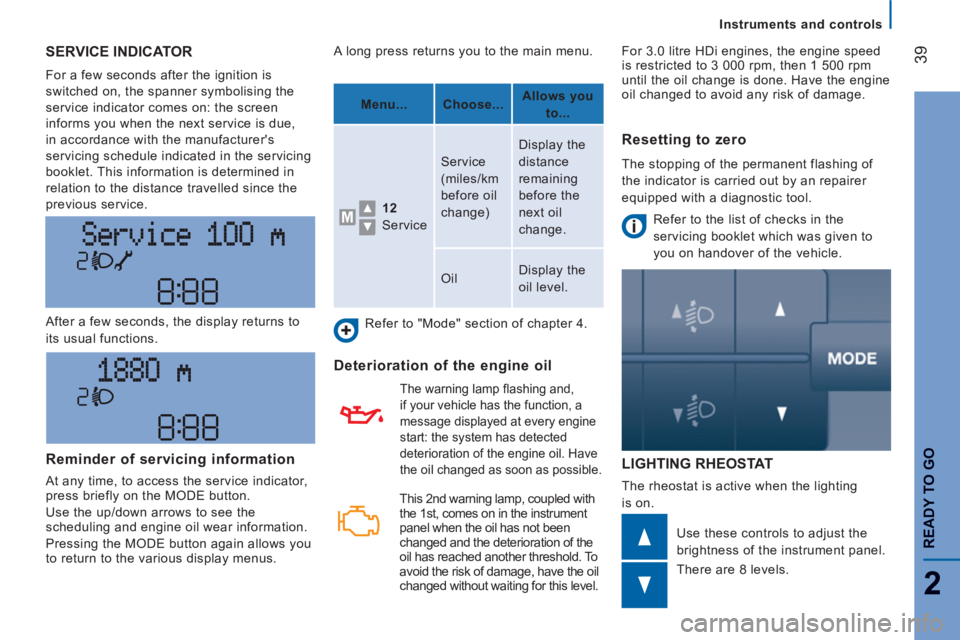
39
2
READY TO G
O
Instruments and controls
SERVICE INDICATOR
For a few seconds after the ignition is
switched on, the spanner symbolising the
service indicator comes on: the screen
informs you when the next service is due,
in accordance with the manufacturer's
servicing schedule indicated in the servicing
booklet. This information is determined in
relation to the distance travelled since the
previous service.
LIGHTING RHEOSTAT
The rheostat is active when the lighting
is on. After a few seconds, the display returns to
its usual functions.
Use these controls to adjust the
brightness of the instrument panel.
There are 8 levels. A long press returns you to the main menu.
Refer to "Mode" section of chapter 4.
Deterioration of the engine oil
The warning lamp fl ashing and,
if your vehicle has the function, a
message displayed at every engine
start: the system has detected
deterioration of the engine oil. Have
the oil changed as soon as possible.
Reminder of servicing information
At any time, to access the service indicator,
press briefly on the MODE button.
Use the up/down arrows to see the
scheduling and engine oil wear information.
Pressing the MODE button again allows you
to return to the various display menus.
Menu...
Choose...
Allows you
to...
12
Service Service
(miles/km
before oil
change) Display the
distance
remaining
before the
next oil
change.
Oil Display the
oil level.
Resetting to zero
The stopping of the permanent flashing of
the indicator is carried out by an repairer
equipped with a diagnostic tool.
Refer to the list of checks in the
servicing booklet which was given to
you on handover of the vehicle. For 3.0 litre HDi engines, the engine speed
is restricted to 3 000 rpm, then 1 500 rpm
until the oil change is done. Have the engine
oil changed to avoid any risk of damage.
This 2 nd warning lamp, coupled with
the 1 st , comes on in the instrument
panel when the oil has not been
changed and the deterioration of the
oil has reached another threshold. To
avoid the risk of damage, have the oil
changed without waiting for this level.